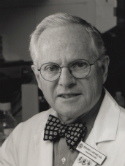Hexamethylene bisacetamide‐induced differentiation of transformed cells: Molecular and cellular effects and therapeutic application Journal Article
| Authors: | Marks, P. A.; Rifkind, R. A. |
| Article Title: | Hexamethylene bisacetamide‐induced differentiation of transformed cells: Molecular and cellular effects and therapeutic application |
| Abstract: | Hexamethylene bisacetamide (HMBA), a highly polar compound, induces murine erythroleukemia (MEL) cells to express the erythroid phenotype, including cessation of proliferation. Inducer‐mediated differentiation of MEL (DS19) cells is a multistep process characterized by a latent period during which a number of changes occur including alterations in ion flux, an increase in membrane‐bound protein kinase C (PKC) activity, the appearance of Ca2+ and phospholipid‐independent PKC activity in the cytosol, and modulation in expression of a number of genes such as c‐myc, c‐myb, c‐fos and the p53 genes. HMBA‐mediated commitment to terminal differentiation is first detected at about 12 hours and increases in a stochastic fashion until over 95% of the population is recruited to terminal differentiation by 48 to 60 hours. Commitment is associated with persistent suppression of c‐myb gene expression. By 36 to 48 hours, transcription of the globin genes has increased 10 to 30 fold, whereas transcription from rRNA genes is suppressed. The steroid, dexamethasone, or the tumor promoter, phorbol‐12‐myristate‐13‐acetate (TPA), suppress HMBA‐induced MEL cell terminal differentiation. These agents appear to act at a late step during the latent period. MEL cell lines derived from DS19 by selection for resistance to vincristine are: 1) induced to commit without a detectable latent period, 2) markedly more sensitive to HMBA, and 3) resistant to dexamethasone or TPA inhibition of HMBA‐induced commitment. The data suggests that vincristine‐resistant MEL cells express a factor which circumvents essential HMBA‐mediated early events. In vitro studies with HMBA provide a basis for the application of HMBA to clinical therapy of human cancers. Clinical trials with HMBA have been initiated. Copyright © 1988 AlphaMed Press |
| Keywords: | controlled study; review; nonhuman; animal cell; mouse; phenotype; animal; cytology; mice; heredity; gene expression; cell differentiation; tumor cells, cultured; oncogene; cell culture; cell transformation; globin gene; protein kinase c; tumor promoter; phorbol 13 acetate 12 myristate; leukemia, erythroblastic, acute; erythroleukemia; hexamethylenebisacetamide; hexamethylene bisacetamide; acetamides; human; support, u.s. gov't, p.h.s.; murine erythroleukemia cells; differentiation of transformed cells |
| Journal Title: | International Journal of Cell Cloning |
| Volume: | 6 |
| Issue: | 4 |
| ISSN: | 0737-1454 |
| Publisher: | AlphaMed Press |
| Date Published: | 1988-07-01 |
| Start Page: | 230 |
| End Page: | 240 |
| Language: | English |
| DOI: | 10.1002/stem.5530060402 |
| PUBMED: | 3047266 |
| PROVIDER: | scopus |
| DOI/URL: | |
| Notes: | Article -- Source: Scopus |
Altmetric
Citation Impact
BMJ Impact Analytics
Related MSK Work




